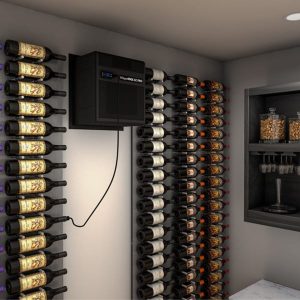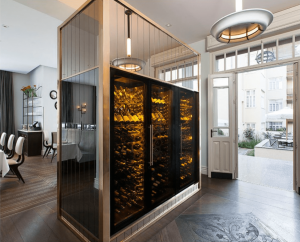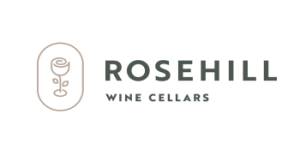A delicious wine begins with a simple blend of grapes and yeast. The ingredients undergo a natural fermentation process. For that reason, natural sugars, carbohydrates, amino acids, phenols, and other elements alter the wine. As a result, a helpful wine care guide will help you gracefully age your collection.
Many subtle variations influence the fermentation process. It begins with how the grapes are sourced or how much yeast is used in the process. External environmental factors also influence the fermentation. As a result, the ambience of the temperature, the degree of humidity, and the length of storage time impact the aging process.
First wine care guide tip: temperature
 Wine experts have determined how different temperatures influence the wine aging process. The best storage temperature falls in a range between 12-14 °C (54-57 °F). This is the optimal temperature range to help aging proceed at a natural rate.
Wine experts have determined how different temperatures influence the wine aging process. The best storage temperature falls in a range between 12-14 °C (54-57 °F). This is the optimal temperature range to help aging proceed at a natural rate.
It’s also known that wine should never be stored at a temperature below -4 °C (25 °F). Because extreme temperatures sour the taste of wine, below recommended temperatures will freeze the wine. On the other end of the spectrum, wine should never be stored at temperatures that exceed 20 °C (68 °F). Consequently, this will accelerate the aging process, distill volatile compounds, and turn the wine into an acidic vinegar.
Wine storage duration time influences temperature
Some wines are best enjoyed almost immediately after they’re bottled. In other cases, more subtle flavours and textures are unlocked when bottles are stored in a proper wine storage cellar for many years on end.
Setting the right temperature for your wine storage cellar depends on the length of time you intend to store your bottles. Generally speaking, wines you will drink in a 1-2 year time span benefit from an accelerated aging process. The optimal storage temperature ranges between 12-14 °C. A slight increase of 2-3 °C can help accelerate the aging process without spoiling the wine.
On the other hand, wine that’s intended for multi-year or multi-decade storage requires a slightly cooler ambience. In these instances, turn the temperature in your cellar storage space down 2-3 °C to slow the aging process. The aging process will still occur naturally. But it will proceed at a slower pace that will improve the quality of the wine when you finally uncork the bottle.
Chilled wine, supreme taste
Create the perfect wine storage temperature with a premium wine cooler.
Wine care guide: cork tips
Most wine corks are sourced from cork oak trees, commonly found in southwestern Europe and northwestern Africa. Corks that are sourced from cork oak trees are natural materials that can endure for many decades without deterioration.
The purpose of wine corks is to seal the vintage within the bottle and prevent oxygen from leaking through the seal. Oxygen in wine triggers the process known as oxidation, which is what causes compounds within wine to distill down into a harsh vinegar.
No wine seal is completely foolproof, and oxygen will seep through even the most secure wine cork. The key to a finely aged wine is to use corks that restrict all but the bare minimum amount of oxygen from leaking beyond the seal. A natural-sourced wine cork allows less than one milligram of oxygen per year to seep into the bottle. It doesn’t get much more secure than that.
How does humidity affect wine cork durability?
 Once you seal the wine, you must preserve the wine cork for longer rather than shorter periods of time. The temperature of your wine storage cellar can help preserve the integrity of the wine cork, or contribute to its breakdown over time.
Once you seal the wine, you must preserve the wine cork for longer rather than shorter periods of time. The temperature of your wine storage cellar can help preserve the integrity of the wine cork, or contribute to its breakdown over time.
Humidity is one of the biggest environmental factors that influences the integrity of your wine corks. Environments that are too humid or too muggy may cause the wine cork to deteriorate and corrupt the wine with unwanted mold. On the other hand, an environment that’s too dry can dry the cork out. Thus, the cork will crumble and increase airflow into the wine bottles.
A relative humidity level ranging between 50-70% is optimal to store your wine and preserve the integrity of your wine corks. If possible, keep the humidity close to the midpoint 60% level as this is the ideal humidity level for the preservation of your wine corks.
Here’s another helpful wine care guide tip. Make sure you set the ideal humidity level for your wine cellar using one of our premium wine cellar humidifiers. They’re designed to deliver superior performance and reliability. This creates the perfect atmosphere to gracefully age your wines.
What about storage angles for your wine bottles?
If you’ve heard fellow wine connoisseurs discuss storing bottles at a certain angle, you might wonder what the fuss is all about. Well, there is a reason for strategic bottle positioning.
Part of what helps wine corks maintain their integrity to preserve the quality of your wine is dampness. Remember that creating too humid conditions causes the cork to dry out, crumble, and allow unwanted oxygen to spoil the wine.
Storing wine at the proper angle dampens the cork and prevents it from drying out. The cork will remain secure in the bottle for years on end so that you can preserve your wines for very special occasions.
If you want some assistance creating the proper wine storage angles, consider purchasing one of our decorative wine racks. Most of our selections can be customized to your specifications. All our products help protect the integrity of your wine corks and, by extension, support the wine aging process with a graceful finish.
At what temperature should you serve your aged wines?
Once your wines have properly aged and are ready for that special gathering, what is the best temperature to serve your wine collection?
Generally speaking, you should serve white wines from a temperature ranging between 8-12 °C. There are slight differences in the types of white wines, which can shift the optimal serving temperature by one or two degrees plus or minus the average range. If you’re unsure, consult with a fellow wine expert for some helpful advice.
With red wines, the optimal serving temperature ranges between 15-18 °C. The age and robustness of the wine will skew that serving range by one or two degrees. Softer reds can be chilled at a cooler temperature, while more bolder and drier reds should be a degree or two above average.
You can use one of our unique decanters and carafes to assist with the serving process. The serving devices give your newly uncorked bottles time to breathe prior to a tasting, creating the perfect balance and enhancing the quality of your wine tasting experience.
Serve your wine with eloquence
Give your wine time to breathe prior to serving your guests.





